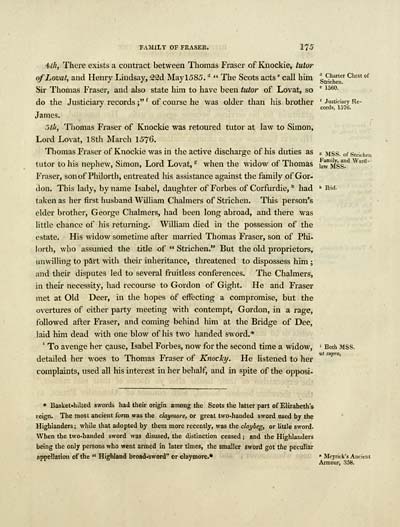Download files
Complete book:
Individual page:
Thumbnail gallery: Grid view | List view

FAMILY OF FRASEE. 175
4///, There exists a contract between Thomas Fraser of Kiiockie, tutor
ofLovat, and Henry Lindsay, 22d Mayl585. " " The Scots acts ' call him gtrich"," ^''*" "^
Sir Thomas Fraser, and also state him to have been tutor of Lovat, so ' ^^^°-
do the Justiciary records ;" ^ of course he was older than his brother ' Justiciary Re-
•^ ' cords, 1576.
James.
Stk, Thomas Fraser of Knockie was retoured tutor at law to Simon,
Lord Lovat, 18th March 1576.
Thomas Fraser of Knockie was in the active discharge of his duties as e mss. of snichen
tutor to his nephew, Simon, Lord Lovat, ^ when the widow of Thomas law^iiss"'' ^^"^'
Fraser, sonof Philorth, entreated his assistance against the family of Gor-
don. This lady, by name Isabel, daughter of Forbes of Corfurdie, " had ' ibid.
taken as her first husband William Chalmers of Strichen. This person's
elder brother, George Chalmers, had been long abroad, and there was
little chance of his returning. William died in the possession of the
estate. His widow sometime after married Thomas Fraser, son of Phi-
lorth, who assumed the title of " Strichen." But the old proprietors,
imwilling to part with their inheritance, threatened to dispossess him ;
and their disputes led to several fruitless conferences. The Chalmers,
in their necessity, had recourse to Gordon of Gight. He and Fraser
met at Old Deer, in the hopes of effecting a compromise, but the
overtures of either party meeting ynth contempt, Gordon, in a rage,
followed after Fraser, and coming behind him at the Bridge of Dee,
laid him dead with one blow of his two handed sword.*
' To avenge her cause, Isabel Forbes, now for the second time a widow, ' Both Mss.
detailed her woes to Thomas Fraser of KnocTcy. He listened to her
complaints, used all his interest in her behalf, and in spite of the opposi-
* Basket«hiUed swords had their origin among the Scots the latter part of Elizabeth's
reign. The most ancient form was the claymore, or great two-handed sword used by the
Highlanders; while that adopted by them more recently, was the claybeg, or little sword.
When the two-handed sword was disused, the distinction ceased ; and the Highlanders
being the only persons who went armed in later times, the smaller sword got the peculiar
appellatiou of the " Highland broad-sword" or claymore.* * Mcyrick's AiKJent
Armour, 358.
4///, There exists a contract between Thomas Fraser of Kiiockie, tutor
ofLovat, and Henry Lindsay, 22d Mayl585. " " The Scots acts ' call him gtrich"," ^''*" "^
Sir Thomas Fraser, and also state him to have been tutor of Lovat, so ' ^^^°-
do the Justiciary records ;" ^ of course he was older than his brother ' Justiciary Re-
•^ ' cords, 1576.
James.
Stk, Thomas Fraser of Knockie was retoured tutor at law to Simon,
Lord Lovat, 18th March 1576.
Thomas Fraser of Knockie was in the active discharge of his duties as e mss. of snichen
tutor to his nephew, Simon, Lord Lovat, ^ when the widow of Thomas law^iiss"'' ^^"^'
Fraser, sonof Philorth, entreated his assistance against the family of Gor-
don. This lady, by name Isabel, daughter of Forbes of Corfurdie, " had ' ibid.
taken as her first husband William Chalmers of Strichen. This person's
elder brother, George Chalmers, had been long abroad, and there was
little chance of his returning. William died in the possession of the
estate. His widow sometime after married Thomas Fraser, son of Phi-
lorth, who assumed the title of " Strichen." But the old proprietors,
imwilling to part with their inheritance, threatened to dispossess him ;
and their disputes led to several fruitless conferences. The Chalmers,
in their necessity, had recourse to Gordon of Gight. He and Fraser
met at Old Deer, in the hopes of effecting a compromise, but the
overtures of either party meeting ynth contempt, Gordon, in a rage,
followed after Fraser, and coming behind him at the Bridge of Dee,
laid him dead with one blow of his two handed sword.*
' To avenge her cause, Isabel Forbes, now for the second time a widow, ' Both Mss.
detailed her woes to Thomas Fraser of KnocTcy. He listened to her
complaints, used all his interest in her behalf, and in spite of the opposi-
* Basket«hiUed swords had their origin among the Scots the latter part of Elizabeth's
reign. The most ancient form was the claymore, or great two-handed sword used by the
Highlanders; while that adopted by them more recently, was the claybeg, or little sword.
When the two-handed sword was disused, the distinction ceased ; and the Highlanders
being the only persons who went armed in later times, the smaller sword got the peculiar
appellatiou of the " Highland broad-sword" or claymore.* * Mcyrick's AiKJent
Armour, 358.
Set display mode to:
![]() Universal Viewer |
Universal Viewer | ![]() Mirador |
Large image | Transcription
Mirador |
Large image | Transcription
Images and transcriptions on this page, including medium image downloads, may be used under the Creative Commons Attribution 4.0 International Licence unless otherwise stated. ![]()
| Histories of Scottish families > Historical account of the family of Frisel or Fraser, particularly Fraser of Lovat > (193) Page 175 |
|---|
| Permanent URL | https://digital.nls.uk/94947982 |
|---|
| Description | A selection of almost 400 printed items relating to the history of Scottish families, mostly dating from the 19th and early 20th centuries. Includes memoirs, genealogies and clan histories, with a few produced by emigrant families. The earliest family history goes back to AD 916. |
|---|

